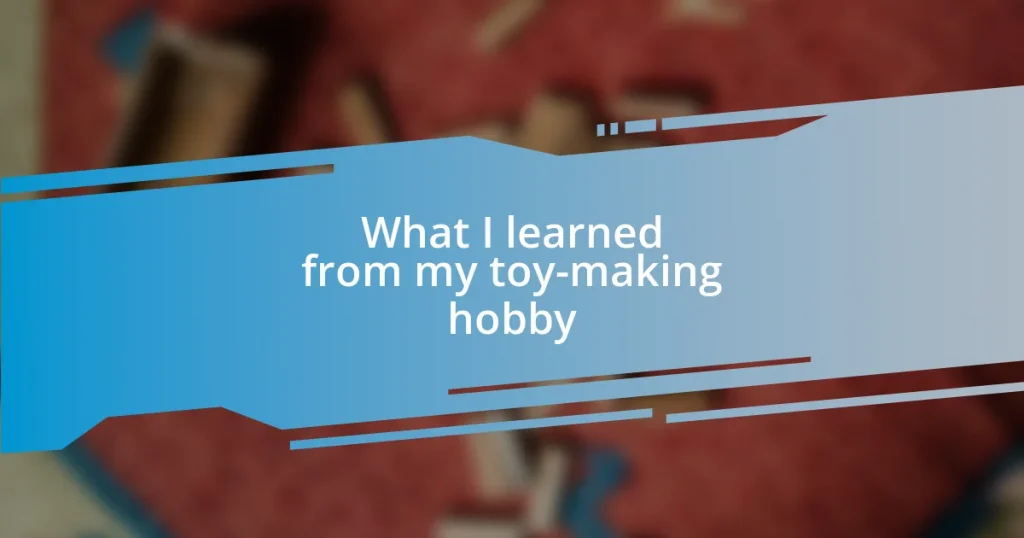Key takeaways:
- Incorporating toys into lessons transforms learning into a playful experience, fostering engagement and discussion among children.
- Creative play-based activities, like scavenger hunts and role-playing, enhance critical thinking and facilitate natural skill development while making learning enjoyable.
- Monitoring children’s progress during play reveals cognitive development milestones, allowing for tailored future activities that nurture their interests and skills.

Incorporating toys into daily lessons
When I first started incorporating toys into our daily lessons, I didn’t realize the transformation it would bring. One day, I introduced building blocks during a math lesson, and suddenly, counting wasn’t just about numbers—it became a playful challenge. How often do we overlook the power of play? That day, I realized play isn’t just a break; it’s a legitimate learning tool.
During science lessons, I often pull out our dinosaur figurines. As we explore different habitats, watching the kids group them based on where they would live is priceless! It sparks curiosity and, just as importantly, discussion. Have you ever noticed how kids open up when they’re playing? It’s like a gateway to their minds.
Even in language arts, we’ve made use of stuffed animals. Each toy turns into a character in our stories, giving life and emotion to the lessons. There’s a special joy when my child narrates tales with their beloved teddy giving the most dramatic performance—it’s something I cherish! Isn’t it incredible how toys can turn learning into a memorable adventure?

Creative play-based learning activities
One afternoon, I decided to introduce a themed scavenger hunt using our toy animals. I created simple clues that led my children through the backyard, where they had to find specific animals based on their habitat. The excitement on their faces as they discovered each toy and solved the clues was a moment I won’t forget. It turned learning into an adventure, allowing them to explore nature while fostering critical thinking in an engaging way.
Here are some more creative play-based learning activities I’ve integrated:
- Puzzle Time: I use puzzles related to various subjects, which not only enhance their problem-solving skills but also boost their perseverance.
- Pretend Play: Setting up a mini store with play money incorporates math skills naturally as we “sell” and “buy” items.
- Craft Creation: Using arts and crafts to recreate historical events can lead to a tactile understanding of the past.
- Role-playing: Each week, we create a story where they enact different roles, helping them learn empathy and enrich their vocabulary.
- Sensory Bins: Filling bins with rice, beans, or water beads lets younger kids explore texture while counting or sorting different items, blending sensory play with learning.
I can’t emphasize enough how these activities not only teach skills but also bring joy and laughter to our learning environment!

Monitoring progress with toy-based learning
Monitoring progress in toy-based learning is more than just observing what my kids do; it’s about noticing how they grow through play. For instance, while we engaged in a Lego-building session, I saw my youngest daughter move from simply stacking blocks to creating intricate structures. It was a joy to witness, and it made me realize that play is a fantastic indicator of cognitive development. Have you ever thought about how such moments can reflect learning milestones?
To assess their progress, I make it a point to keep track of the skills they’re using during play. When my son built a model city with toy cars and blocks, he practiced spatial awareness and fine motor skills without even realizing it. It became a natural opportunity to discuss concepts like balance and design while celebrating his creativity. I often wonder, wouldn’t we all benefit from recognizing learning in every playful moment?
Reflecting on their play sessions also helps me tailor future activities. After noticing my daughter enjoyed our puppet shows, I introduced her to storytelling books that connected to her favorite characters. This seemingly small step not only kept her engaged but fostered a love for reading. How rewarding it feels to see those connections bloom! Engaging with them during playtime has not only been fun but illuminating, revealing so much about their progress in a way that feels effortless.
















